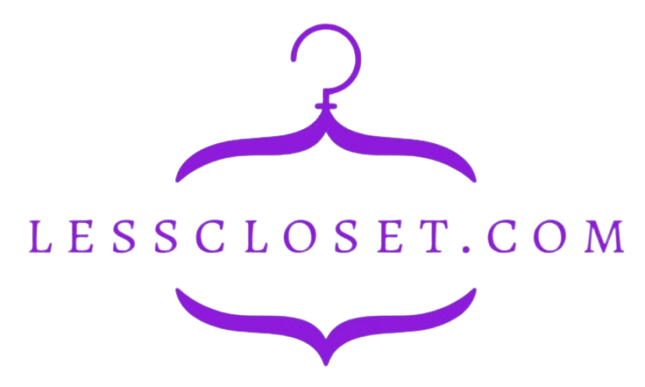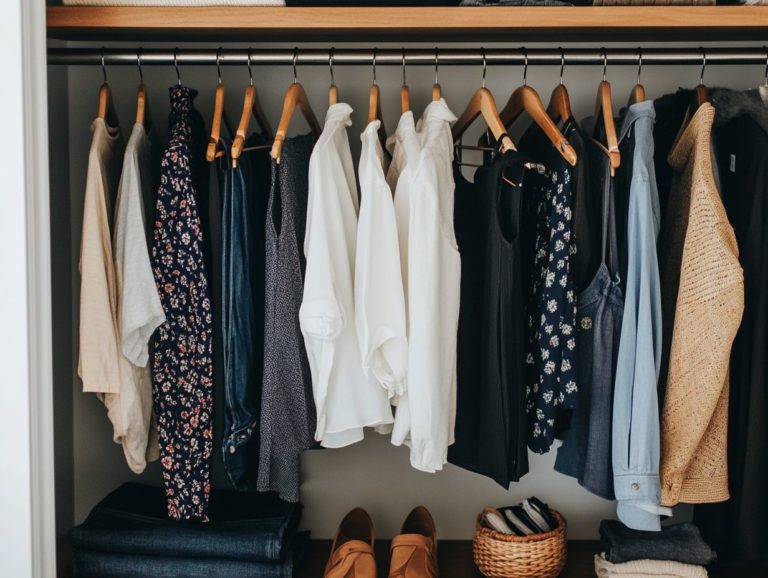How to Develop a Minimalist Style That Lasts for Years
Minimalism is not just a trend; it represents a lifestyle change that embodies clarity, purpose, and peace. This article explores the philosophy of minimalism and highlights its benefits for both the mind and living spaces.
It provides effective strategies for decluttering, such as creating a streamlined wardrobe that prioritizes quality over quantity and simplifying home decor.
You will also find habits that encourage gratitude and intentional living. Dive into a sustainable minimalist style that transforms your life and protects our planet!
Contents
Key Takeaways:
- Unlock the power of minimalism: reduce stress, boost productivity, and curate your wardrobe with timeless pieces!
- Declutter and curate your wardrobe by investing in quality pieces that can withstand the test of time.
- Practice a minimalist lifestyle through mindful consumption, intentional living, and letting go of materialism to maintain your minimalist style for years to come.
The Philosophy of Minimalism
Minimalism is built on simplicity, intentionality, and sustainability. It encourages people to focus on quality rather than quantity.
Minimalism promotes a closet detox that emphasizes mindful consumption and reduces reliance on fast fashion. A minimalist wardrobe enhances our fashion choices and supports ethical fashion practices, as exemplified by figures like Marie Kondo, who highlights the importance of joy and functionality in our wardrobes.
Understanding the Concept and Benefits
The benefits of minimalism are numerous. It promotes sustainable habits and emphasizes quality over quantity in wardrobes. Minimalism encourages individuals to make a list of clothes they own, helping clarify their style goals and reduce the number of clothing items.
This reduction in possessions often leads to emotional relief from the clutter that accumulates in both our mental and physical environments. Financially, opting for fewer, higher-quality clothes instead of many inexpensive items can lead to savings over time.
Environmentally, a minimalist lifestyle reduces waste by fostering awareness of how much we own and often mistakenly purchase. This awareness encourages people to shop for second-hand items or invest a little more in ethical brands that prioritize sustainable practices and materials.
By curating their style thoughtfully, individuals can express themselves while contributing to a more sustainable world.
Creating a Minimalist Wardrobe
A minimalist wardrobe is created through a thoughtful closet detox and careful wardrobe curation, resulting in a capsule collection that features comfortable clothing while eliminating unnecessary items.
This approach simplifies daily clothing choices and allows for developing a personal style that aligns with minimalism. Mindful consumption and clothing swaps can also help refresh your collection, further enhancing your minimalist wardrobe.
Decluttering and Curating Your Clothing
Decluttering and curating your clothing is essential for creating a minimalist wardrobe. This process involves a closet detox and a comprehensive inventory of your wardrobe, focusing on identifying unnecessary pieces.
By prioritizing sustainable habits and emphasizing quality over quantity, you can achieve a more cohesive and efficient collection that reflects your personal style.
The act of decluttering and curating clothing promotes sustainable practices and fosters awareness of wasteful shopping habits. Techniques from professional organizers like Marie Kondo highlight the importance of asking whether each piece sparks joy when deciding if a garment should remain in your wardrobe.
The decluttering process begins by sorting items into categories and tackling one section at a time. This involves making both functional and emotional decisions about each piece. Once the decluttering is complete, maintaining a regular inventory of your wardrobe helps identify any remaining gaps.
Ultimately, this process aids in defining your personal style and ensures that each item serves a unique purpose and function. Furthermore, decluttering your wardrobe is not merely a physical task; over time, the choices you make about what to keep and what to discard can enhance your self-confidence and self-expression.
Investing in Quality Pieces
Investing in quality pieces is essential for building a minimalist wardrobe. It enables individuals to make ethical fashion choices and avoid fast fashion trends.
Quality garments are typically more durable and timeless. This helps reduce environmental waste and fosters sustainable habits aligned with conscious consumerism.
Quality clothing lasts longer, minimizing the need for frequent replacements. This leads to less waste and a lower carbon footprint.
Quality items are often more versatile. They require fewer pieces to create outfits for different occasions.
Ethical fashion brands produce higher-quality items that reflect consumers’ values. This allows them to build conscious wardrobes.
These brands emphasize better craftsmanship and sustainable processes. They promote environmentally friendly practices and fair labor standards.
Minimalist Home Decor
Minimalist home decor extends minimalism from wardrobes into living spaces like the kitchen, bedroom, and garden. This approach creates a minimal aesthetic that emphasizes practicality and natural beauty.
By adopting sustainable habits and decluttering, you can cultivate an organized and serene environment.
Tips for Simplifying Your Living Space
Let’s dive into some exciting tips! Start by decluttering, embracing minimalist home decor, and adopting sustainable habits.
The process begins with evaluating your items. Go through everything and see what truly serves a purpose or brings you joy.
Encourage friends and family to appreciate letting go. Items that no longer fit your lifestyle can be donated or recycled.
When selecting decor, choose multi-functional pieces. Using natural materials and neutral colors helps create a cohesive look.
Consider adding indoor plants; they improve air quality and enhance the minimalist design with a touch of greenery.
Minimalist Lifestyle Practices
Minimalist lifestyle practices involve mindful consumption and intentional living. These practices establish the groundwork for sustainable fulfillment.
While minimalism emphasizes sustainability, it also focuses on appreciating what you already have.
Mindful Consumption and Intentional Living
Mindful consumption and intentional living are vital for a minimalist lifestyle. They encourage thoughtful choices in purchases and daily practices.
This approach fosters a connection with your possessions. It promotes resourcefulness and reduces the negative effects of fast fashion.
Practitioners experience greater fulfillment and reduced anxiety. Intentional living helps focus on what truly matters.
Mindful consumption encourages community involvement. People often share ideas and engage in local initiatives, amplifying positive effects on their lives and the environment.
Practicing Gratitude and Letting Go of Materialism
Practicing gratitude and minimizing materialism are essential components of a minimalist lifestyle. They encourage individuals to appreciate what they have rather than constantly yearning for more.
This mindful approach fosters habits that promote contentment while enhancing personal style without excessive material accumulation. By regularly acknowledging the small pleasures and gifts in their lives, individuals can shift their mindset towards a fuller and more rewarding existence.
The practice of gratitude allows people to step back from the relentless desire for possessions and recognize the value of experiences and relationships. One effective way to cultivate this sense of thankfulness is by maintaining a daily gratitude journal, where individuals write down three things they are grateful for each day. Engaging in mindful practices also helps connect them with the world around them.
This practice not only complements a minimalist lifestyle but also illustrates the principle that less can indeed be more. Individuals begin to better recognize what is truly meaningful in life.
Maintaining a Minimalist Style
A minimalist style is achieved through careful planning and ongoing effort. It ensures that a wardrobe reflects the values of sustainability and thoughtfulness.
Sustainable practices, along with regular closet detoxes, can adapt a wardrobe to evolving fashion trends.
Strategies for Long-Term Success
Achieving long-term success in maintaining a minimalist style requires a commitment to mindful consumption. Ensure that your wardrobe is continually curated to reflect your evolving personal style.
Prioritize quality selections and avoid impulse purchases to create a wardrobe that aligns with your values. Setting specific style goals narrows down your choices, guiding you towards items and brands that resonate with your aesthetic.
Cultivate mindful shopping habits by creating a thoughtful list before outings. This can help you resist the temptation of trendy but impractical items. Regularly evaluate your closet to foster a better understanding of your personal needs and preferences.
This process encourages the elimination of excess and deepens your appreciation for each piece. The result is a more cohesive wardrobe that enhances style longevity and sustainability.
Frequently Asked Questions
- What does it mean to have a minimalist style that lasts for years?
- A minimalist style that lasts for years is a timeless and versatile way of dressing. It focuses on simplicity, functionality, and quality, involving a small number of high-quality pieces that can be mixed and matched to create various outfits.
- How can I start developing a minimalist style?
- The first step is to declutter your wardrobe by getting rid of unnecessary or unused items. Then, focus on investing in high-quality, versatile pieces that you love and can wear in multiple ways, keeping in mind the principles of simplicity, functionality, and quality.
- What are some key pieces to include in a minimalist wardrobe?
- Key pieces include a white t-shirt, a black dress, a tailored blazer, a pair of jeans, and a classic coat. These items can be dressed up or down and mixed and matched to create various outfits.
- How can I make my minimalist style last for years?
- To make your minimalist style last for years, invest in high-quality, timeless pieces rather than following fleeting fashion trends. Take good care of your clothes by following washing instructions and storing them properly to ensure longevity. Incorporate different accessories to change up your outfits without needing to buy new clothes.
- Do I have to get rid of all my clothes to adopt a minimalist style?
- No, you don’t have to get rid of all your clothes. A minimalist style aims for a smaller, more versatile, and intentional wardrobe. You can gradually declutter and replace items with high-quality pieces that align with your minimalist goals.
Don’t miss out on embracing a minimalist lifestyle that can transform your life! Start your journey today and share your experiences in the comments below.
Can I still express my personal style with a minimalist wardrobe?
Yes, you can express your personal style with a minimalist wardrobe. Minimalism allows you to choose your unique style while focusing on simple and practical choices.
You can include your favorite colors, patterns, and silhouettes as long as they emphasize simplicity and quality. You’ll be amazed at how much your style can shine!





